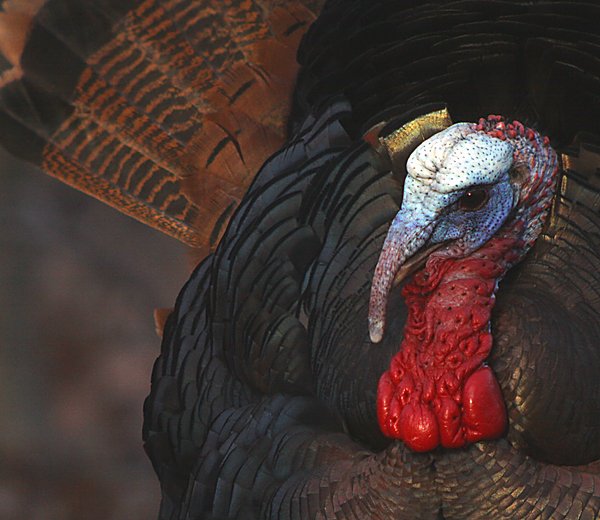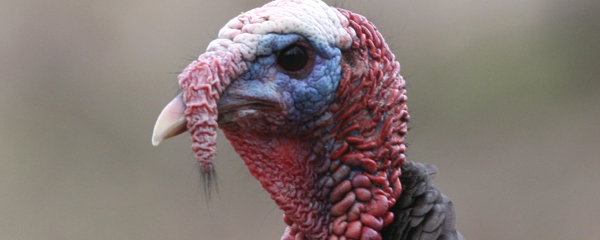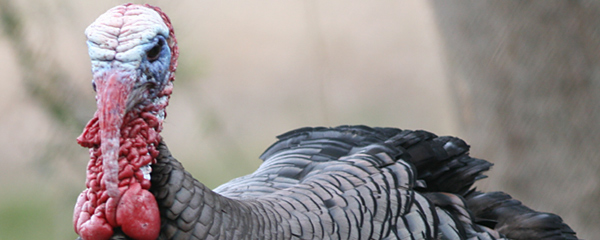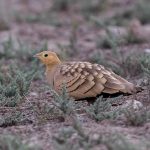
Another year, another (American) Thanksgiving. Time to trot out the turkey facts! This day of thanks is, after all, known as Turkey Day. Please enjoy this 10,000 Birds tradition and enjoy everything you are thankful for this year…

An overwhelming majority of turkeys polled feel that Thanksgiving is not actually Turkey Day. In fact, it seems a lot more like Anti-Turkey Day. Yes, the Wild Turkey is North America’s largest game bird. However, Meleagris gallopavo has a lot more going for it than tasty, tryptophan-laced flesh:
- Turkeys are social birds and in winter often separate into three distinct groups: adult males (toms), young males (jakes), and females (hens) of all ages.
- Wild turkey populations dwindled to fewer than 30,000 birds by the 1930s due to habitat destruction and unregulated shooting. Today, there are probably more than 7 million wild turkeys. They can be found in every state except Alaska (but see the comments below!)
- Wild turkeys can fly for short distances up to 55 miles per hour. They can run as fast as 20 miles per hour. Commercially raised turkeys cannot fly.
- Turkeys’ heads change colors when they become excited.
- Male turkeys are sometimes called gobblers, which makes sense because they gobble. Hens don’t gobble. They make a clicking noise.
- During the spring, a male wild turkey’s physical appearance changes: his head turns a brilliant red, white and blue color. He can often be seen puffed up, tail feathers fanned out and his wings dragging on the ground. This display is called strutting and the purpose of this display is to attract hens for breeding
- The fleshy growth under a turkey’s throat is called a wattle. Turkeys also have a long, red, fleshy area that grows from the forehead over the bill called a snood. This is not to be confused with the highly addictive computer game with the same name.
- Turkeys can have heart attacks. During U.S. Air Force test runs in breaking the sound barrier, nearby turkeys dropped dead from sudden cardiac arrest.
- The ballroom dance the “turkey trot” was named for the short, jerky steps that turkeys take.
- Turkeys can see in color but have poor night vision.
- Benjamin Franklin disapproved of the selection of the Bald Eagle as our national bird, calling it “a Bird of bad moral Character.” He much preferred the Wild Turkey, saying, “For the Truth the Turkey is in Comparison a much more respectable Bird, and withal a true original Native of America… He is besides, though a little vain and silly, a Bird of Courage, and would not hesitate to attack a Grenadier of the British Guards who should presume to invade his Farm Yard with a red Coat on.”

Happy Thanksgiving from all of us at 10,000 Birds!













Happy Thanksgiving!
Actually, I live in Alaska, and I have seen some turkeys here who did not appear to belong to anyone. I have pictures, if you wish.
http://www.maj.com/gallery/winddancer/details/wildturkeys_1_detail.png
http://www.maj.com/gallery/winddancer/details/wildturkeys_2_detail.png
http://www.maj.com/gallery/winddancer/details/wildturkeys_3_detail.png
http://www.maj.com/gallery/winddancer/details/wildturkeys_4_detail.png
I’m a new birder. Very educational posting. Thank you very much.
Such a perfect post for a perfect holiday! Happy Thanksgiving to you and your family!
Gosh, for a second or two, I actually thought you were giving us some facts about the COUNTRY and wondered why on earth Turkey would feature on 10,000 birds.
Happy Thanksgiving!!!
Happy Thanksgiving Mike and family!
Sweet site!!!!!!!!
This is a really interesting site about turkeys
We wish you all a Happy Thanksgiving and may God be with thoose who are traviling. Remember, the safest way to defrost a turkey is to put it in the fridge. This prevents the spread of Bacteria.
-James and family
We have a turkey that stays in our large backyard most of the time. He is quite large and lame. He may have broken his leg at one time and his one foot is turned in. He may leave for a couple of days then comes home. He sleeps in one of our oak trees. He has been here for about 3 months. He cleans up under the bird feeder and I have fed him some corn and seeds. I don’t know what else I could give him. I call him Gimpy and he seems to listen when I talk to him or else he’s wondering what that crazy lady is saying. I’m always glad to see him go up to bed so I know he is safe for the night. I would appreciate knowing if there is snything else I can do for him. Thanks
Sounds like you’re taking good care of Gimpy already, Pat.
We have not seen Gimpy for a week now. I don’t know what has happened to him. Maybe he decided to go looking for a mate. I would love to see him again. Pat
hey people i love to eat turkeys!
what do turkeys do when it rains?stay roosted or what?
I was out looking for Moose calves the other day, and way out in the middle of nowhere, no houses within miles, i found a Hen Turkey, with 7 chicks, deff. 100% WILD!!!!! many pic’s …170 miles south of Anchorage..
i love turkey ya ya ya ya ya ya ihate justin bieber he should be the turkey
happy thanksgiving to all i love all my family
im a turckeyalogist and me and my coworker are so thankful for this turckey info! gobble gobble (jk you people are freaks 🙂
im a turkeyalogist and me and my coworker are very thankful for your info! gobble gobble freak..:)
I am waging an ineffective, one-man, on-again-off-again campaign to have the AOU change the name of Wild Turkey. The use the adjective ‘wild’ is demeaning, and discriminatory. Of course they’re wild! They would be better named ‘Woodland Turkey, Running Turkey or something like that. We don’t talk about Wild Kingbirds or Wild Gannets; it’s silly.
I have posted a heartfelt essay on this embarrassing, short-sighted neglect by the birding establishment on my blog at http://www.mybirdoftheday.ca/woodland-turkey/
Join me in my campaign and send me money to help finance the overthrow of the nomenclature powers
I never knew turkeys can for 55 miles per hour. Fascinating bird.
Where are these wild turkeys in Alaska?
Thanksgiving is in 8 days! I had to do an assignment at school on turkeys and it was very helpful.
this is so helpful
Thanks Dave
Let me just say, Turkeys are awesome
GOBBLE! GOBBLE! GOBBLE! I’m a turkeyologist too!! GOBBLE! GOBBLE! GOBBLE!